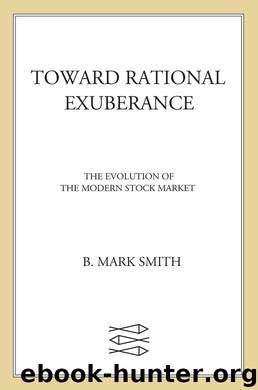Toward Rational Exuberance by B. Mark Smith

Author:B. Mark Smith
Language: eng
Format: epub
Publisher: Farrar, Straus and Giroux
Published: 2011-06-23T04:00:00+00:00
Dividend and Nominal Bond Yields, 1871-1996
From Stocks for the Long Run (1994) by J. Siegel. Reprinted with the permission of The McGraw-Hill Companies.
But the stock market continued to gain ground even after the “great yield reversal” occurred. In fact, stock dividends would never again rise above long-term government bond interest rates. Fears of inflation were not only pushing investors to buy stocks but were also causing bond buyers to demand higher yields. (If bonds were to be paid back with cheaper, “inflated” dollars in the future, anyone holding bonds would need to receive higher interest rates as compensation.) A “revolution” had truly occurred, with “inflation psychology” overwhelming the markets. Adherents to traditional standards of valuation were left in the dust.
Unfortunately, at least as far as some market bulls were concerned, one very important institution, the Federal Reserve System, seemed to be intractably committed to the old standards. In March 1959 the central bank raised its discount rate to 3%, signaling a move toward tighter money. The move was widely seen as a reaction to the rapid rise in stock prices and was much criticized. The New York Times declared the rate increase to be “completely uncalled for,” and The Wall Street Journal labeled the move “unnecessary.” Business Week noted that the “nation’s productive capacity is still not fully utilized …” and warned that “in making this decision, we strongly suspect, the Fed has been influenced too much by what has been going on in the stock market, and not enough by what has been going on in business as a whole.” The dilemma the Fed had first faced (and badly mishandled) in the 1920s seemed to be recurring: Given the increasing importance of the stock market to the broader economy, could (or should) the central bank attempt to restrain what was perceived as market excess?
The average dividend yield on New York Stock Exchange—listed stocks had fallen from more than 6.5% in 1950 to under 3.25% in 1959. Over the same period, the P/E ratio for NYSE-listed stocks rose from approximately 7 to 1 to 17 to 1. Stock prices had advanced approximately 250% faster than earnings. Obviously this sharp upward revaluation reflected at least in part a rebound from the abnormally depressed valuations of the late 1940s. But just as obviously, the market seemed to have moved beyond a normal recovery into entirely new territory, a state of affairs that made many observers nervous.
The March 1959 edition of Fortune attempted to provide a comprehensive explanation of what was happening. The article quoted unnamed financial columnists who saw the market’s rise as a sign of “quiet desperation” about the “coming inflation.” But Fortune also found other reasons for the market’s strong performance.
One obvious source of buying came from rapidly growing institutional participation in the market. Fortune reported that in 1957 mutual funds accounted for $2.3 billion, or 62% of the net buying of stocks, with pension funds responsible for $1 billion more, or 27% of total net buying. Together these institutional purchases represented 89% of all net buying.
Download
This site does not store any files on its server. We only index and link to content provided by other sites. Please contact the content providers to delete copyright contents if any and email us, we'll remove relevant links or contents immediately.
International Integration of the Brazilian Economy by Elias C. Grivoyannis(88018)
The Radium Girls by Kate Moore(11896)
Turbulence by E. J. Noyes(7918)
Nudge - Improving Decisions about Health, Wealth, and Happiness by Thaler Sunstein(7533)
The Black Swan by Nassim Nicholas Taleb(6984)
Rich Dad Poor Dad by Robert T. Kiyosaki(6353)
Pioneering Portfolio Management by David F. Swensen(6207)
Man-made Catastrophes and Risk Information Concealment by Dmitry Chernov & Didier Sornette(5897)
Zero to One by Peter Thiel(5657)
Secrecy World by Jake Bernstein(4615)
Millionaire: The Philanderer, Gambler, and Duelist Who Invented Modern Finance by Janet Gleeson(4350)
The Age of Surveillance Capitalism by Shoshana Zuboff(4185)
Skin in the Game by Nassim Nicholas Taleb(4141)
Bullshit Jobs by David Graeber(4059)
The Money Culture by Michael Lewis(4050)
Skin in the Game: Hidden Asymmetries in Daily Life by Nassim Nicholas Taleb(3904)
The Dhandho Investor by Mohnish Pabrai(3678)
The Wisdom of Finance by Mihir Desai(3625)
Blockchain Basics by Daniel Drescher(3471)
